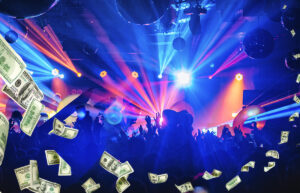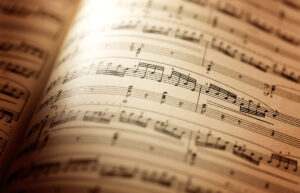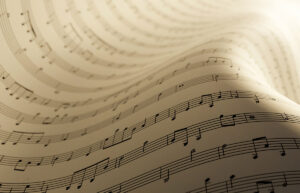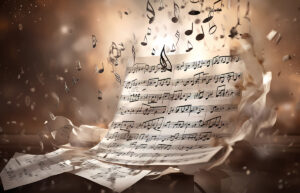How to Draw Music Notes: Meaning, Types, Steps & More

Welcome to the world where sound meets artistry! Have you ever wondered how those intricate symbols on a musical staff come to life on paper? In this guide on how to draw music notes, we’ll unravel the mysteries of drawing music notes, inviting you to pick up your pencil and join the rhythm. Prepare to delve into the creative symphony where lines, curves, and dots transform into the language of melodies. Let’s embark on a harmonious journey, blending the realms of music and art, as we uncover the secrets of drawing music notes together!
Welcome to TheDemoStop, now join the community!
Connect with artists, fans and producers around the world.
What is a musical note?
Before deciphering how to draw music notes, its essential to know what is a musical note. A musical note is a symbol used in musical notation to represent the pitch and duration of a sound. It communicates to musicians how high or low a sound should be (pitch) and how long it should be held (duration). These notes are placed on a staff consisting of lines and spaces, each representing a specific pitch.
Musical notes include various elements like the note head, stem, flag, or beam, and they come in different shapes (such as whole notes, half notes, quarter notes, etc.) to convey different durations or lengths of sound.
Why is it important to learn how to draw musical notes?
Understanding how to draw music notes is crucial for musicians as it enables them to visually interpret musical concepts like pitch, rhythm, and duration. This visual representation facilitates more transparent communication of musical ideas between composers, performers, and learners. It also assists in memorizing musical pieces by associating visual symbols with corresponding sounds, aiding in faster learning and retention.
Moreover, drawing musical notes isn’t just about replication; it invites creativity. Musicians can personalize their scores, adding artistic elements that enhance the visual appeal while maintaining the musical notation’s accuracy and readability.
Proficiency in drawing music notes fosters seamless collaboration among musicians during rehearsals and performances. It ensures that everyone understands the music in the same way, leading to cohesive and harmonious musical renditions. Lastly, this skill transcends specific instruments or musical genres. Whether reading sheet music for piano, guitar, violin, or any other instrument or delving into classical, jazz, pop, or other musical styles, a solid understanding of drawing music notes remains a fundamental and adaptable skill for any musician.
Types of musical notes
Understanding how to draw music notes is fundamental for anyone delving into musical notation. Learning the types of musical notes is an essential step in translating the language of music from notation to audible melodies.
Whole note (Semibreve)
The whole note is an open oval-shaped symbol without a stem. It represents the longest note duration in Western musical notation, typically lasting for four beats in common time. It indicates a sustained sound for the duration of a whole measure.
Half note (Minim)
Represented by an open oval with a stem, the half note lasts for two beats in common time. It’s half the duration of a whole note. When a half note is paired with a dot next to it, it adds half of its original value, extending its duration by an additional beat.
Quarter note (Crotchet)
The quarter note is a closed oval shape with a stem. It lasts for one beat in common time and is the foundation of rhythmic patterns in music. It’s commonly used to construct rhythms and melodies in various musical compositions.
Eighth note (Quaver)
Recognizable by its closed oval shape with a stem and a flag, the eighth note lasts for half a beat in common time. Two eighth notes are equivalent in duration to a one-quarter note. They often appear in pairs or groups, contributing to syncopated rhythms and melodies.
Sixteenth note (Semiquaver)
These notes, with two flags or beams, represent a duration of one-fourth of a beat in common time. Four sixteenth notes equal the duration of a one-quarter note. They are utilized in complex rhythms, adding intricacy and speed to musical passages.
Thirty-second note (Demisemiquaver)
Thirty-second notes have three flags or beams attached, denoting a duration of one-eighth of a beat in common time. They’re used in highly intricate and fast-paced passages, especially in genres like classical music, where rapid articulation is required.
How to draw music notes- step-by-step guide?
These steps guide the basic construction of how to draw music notes and symbols, enabling musicians and learners to visually represent the various durations and pitches within musical compositions.
Draw or trace a slanted circle
Start by sketching or tracing a slanted oval or circle to create the basic structure for notes like whole notes (semibreve), half notes (minims), and quarter notes (crotchets).
Draw the first symbol of the beam note
To create notes with beams (like eighth notes, sixteenth notes, etc.), begin with an oval or closed shape and add the initial stem or flag. This serves as the foundation for the note with beams.
Finalize the form of the beam note
Add beams or flags to the stem, extending from the notehead. For right notes (quavers), this involves attaching a single flag; for sixteenth notes (semiquavers), it requires multiple beams.
Draw the flag of the quaver note
For an eighth note (quaver), draw a single flag at the end of the stem. The flag usually resembles a curved line or lines extending from the stem.
Welcome to TheDemoStop, now join the community!
Connect with artists, fans and producers around the world.
Draw the head of the quaver note
Create the notehead, usually an oval or closed shape, attached to the stem. Ensure the head is appropriately sized and positioned relative to the stem.
Draw the straight line of the treble clef
To draw the treble clef symbol, start with a straight line oriented slightly to the right, forming the base of the clef.
Draw a small curve on the right side
Add a small curve or hook on the right side of the line, which is the starting point for the loop of the treble clef symbol.
Draw the S-shaped line of the clef
Form an “S” shape that curves around the starting point and intersects the straight line, creating the main body of the treble clef.
Complete the form of the treble clef
Finalize the details and proportions of the treble clef, ensuring that the curves and loops are smooth and well-defined.
Draw a whole note
For a whole note (semibreve), create an open oval without a stem. It should represent the longest duration among the common notes.
Form a sixteenth note
To draw a sixteenth note (semiquaver), start with an oval or closed shape, add the stem, and attach multiple beams or flags to signify the shorter duration.
Draw an eighth note
Similar to the previous steps for drawing eighth notes (quavers), create an oval or closed shape, add a stem, and attach a single flag to the end of the stem.
Music notation software
Music notation software plays a crucial role in how to draw music notes by providing a user-friendly platform for composers, arrangers, and musicians to create, edit, and share musical compositions in a digital format.
MuseScore
MuseScore is a free and open-source music notation software known for its user-friendly interface and comprehensive features. It allows musicians, composers, and educators to create, edit, and print sheet music. MuseScore offers a wide range of musical symbols, supports various instruments and ensembles, and enables playback of written scores.
Sibelius
Sibelius is a professional-grade music notation software used by composers, arrangers, and publishers worldwide. Known for its powerful features, it offers sophisticated tools for composing, arranging, and sharing music. Sibelius allows users to create complex scores, orchestral arrangements, and professional-quality compositions. It includes advanced playback features and integrates well with other music production software.
Noteflight
Noteflight is a web-based music notation software accessible through a browser. It allows users to create, edit, and share music scores online. Noteflight offers collaborative features, enabling real-time collaboration among multiple users on the same score. It’s known for its ease of use and accessibility across various devices.
QuickScore Elite Level II
QuickScore Elite Level II is a music composition and notation software designed for composers, songwriters, and arrangers. It provides various tools for creating musical compositions, from simple melodies to complex orchestral arrangements. It offers MIDI functionality and advanced notation features and supports various file formats for compatibility with other software.
Musink
Musink is a free music composition software tailored for musicians, composers, and music educators. It focuses on simplicity and speed, allowing users to create music notation quickly and intuitively. Musink is particularly known for its user-friendly interface and its ability to generate sheet music while keeping the workflow efficient.
ScoreCloud Studio
ScoreCloud Studio is an innovative music notation software that utilizes audio input to transcribe melodies, harmonies, and rhythms into sheet music notation. It enables users to directly sing or play an instrument into the software, which converts the audio input into musical notation. It’s suitable for musicians who prefer a more direct and interactive approach to music notation.
Conclusion
What is a musical note?
In musical notation, a musical note is a symbol that denotes the pitch and duration of a sound. These symbols, which are used to indicate different durations of time and musical tones, are arranged in different shapes on a musical staff.
Why is it important to learn how to draw musical notes?
Learning how to draw musical notes is important as it enables musicians to understand and communicate musical ideas effectively, read and interpret sheet music accurately, and create a visual representation of musical compositions, enhancing the learning process and facilitating collaboration among musicians.
Types of musical notes
- A Whole Note (semibreve)
- A Half Note (minim)
- A Quarter Note (crotchet)
- An Eighth Note (quaver)
- A Sixteenth Note (semiquaver)
- A Thirty-Second Note (demisemiquaver)
How to draw music notes: Step-by-step guide
- Draw or trace a slanted circle
- Draw the first symbol of the Beam note
- Finalize the form of the beam note
- Draw the flag of the quaver note
- Draw the head of the quaver note
- Draw the straight line of the Treble Clef
- Draw a small curve on the right side
- Draw the S-shaped line of the clef
- Complete the form of the treble clef
- Draw a whole note
- Form a sixteenth note
- Draw an eighth note
Music notation software
- MuseScore
- Sibelius
- Noteflight
- QuickScore Elite Level II
- Musink
- ScoreCloud Studio
FAQs
What is a musical note?
A musical note is a symbol used in notation to represent the pitch and duration of a sound in music. It communicates the musical sound’s pitch (how high or low) and duration (how long it lasts).
What are the different types of musical notes?
- A whole note (semibreve)
- A half note (minim)
- A quarter note (crotchet)
- An eighth note (quaver)
- A sixteenth note (semiquaver)
- A thirty-second note (demisemiquaver)
What is a musical note called?
A musical note is called a symbol, used in music notation to represent the pitch and duration of a sound. These symbols are placed on a musical staff, and their variations in shape, such as ovals, circles, and flags with stems, convey different lengths of sound.
Why is learning musical notes important?
Accurately reading and interpreting sheet music, communicating musical ideas, and creating a visual representation of musical compositions are all made possible by being able to draw musical notes. This skill improves learning and fosters collaboration among musicians.
How do you draw notes in music?
In music notation, drawing notes involves using symbols on a staff to represent pitch and duration. These symbols, such as ovals, circles, and flags with stems, indicate different lengths of sound.
How do you draw a note step by step?
- Draw or trace a slanted circle
- Draw the first symbol of the beam note
- Finalize the form of the beam note
- Draw the flag of the quaver note
- Draw the head of the quaver note
- Draw the straight line of the Treble Clef
- Draw a small curve on the right side
- Draw the S-shaped line of the clef
- Complete the form of the treble clef
- Draw a whole note
- Form a sixteenth note
- Draw an eighth note
How do you draw a whole note?
Create an open oval shape without a stem to draw a whole note. This shape resembles a hollow circle and represents the longest duration among common notes in music notation.
What is the easiest music notation software to use?
MuseScore is widely recognized as user-friendly music notation software thanks to its intuitive interface and extensive features. The software is available for free as an open-source application.































































